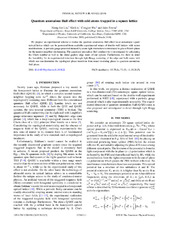| dc.creator | Liu, Xiong-Jun | |
| dc.creator | Liu, Xin | |
| dc.creator | Wu, Congjun | |
| dc.creator | Sinova, Jairo | |
| dc.date.accessioned | 2011-09-08T21:36:40Z | |
| dc.date.available | 2011-09-08T21:36:40Z | |
| dc.date.issued | 2010 | |
| dc.identifier.citation | Xiong-Jun Liu, Xin Liu, Congjun Wu and Jairo Sinova. Phys.Rev.A 81 033622 2010. "Copyright (2010) by the American Physical Society." | en |
| dc.identifier.uri | http://dx.doi.org/10.1103/PhysRevA.81.033622 | |
| dc.identifier.uri | https://hdl.handle.net/1969.1/126640 | |
| dc.description | Journals published by the American Physical Society can be found at http://publish.aps.org/ | en |
| dc.description.abstract | We propose an experimental scheme to realize the quantum anomalous Hall effect in an anisotropic square optical lattice which can be generated from available experimental setups of double-well lattices with minor modifications. A periodic gauge potential induced by atom-light interaction is introduced to give a Peierls phase for the nearest-neighbor site hopping. The quantized anomalous Hall conductivity is investigated by calculating the Chern number as well as the chiral gapless edge states of our system. Furthermore, we show in detail the feasability for its experimental detection through light Bragg scattering of the edge and bulk states with which one can determine the topological phase transition from usual insulating phase to quantum anomalous Hall phase. | en |
| dc.language.iso | en | |
| dc.publisher | American Physical Society | |
| dc.subject | CONDUCTANCE | en |
| dc.subject | WELLS | en |
| dc.subject | Optics | en |
| dc.subject | Physics | en |
| dc.title | Quantum anomalous Hall effect with cold atoms trapped in a square lattice | en |
| dc.type | Article | en |
| local.department | Physics and Astronomy | en |


